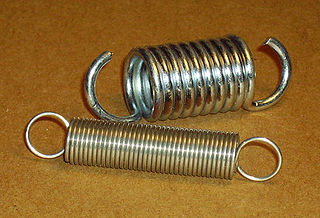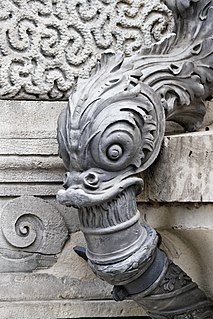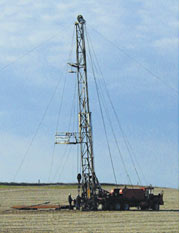This article has multiple issues. Please help to improve it or discuss these issues on the talk page . (Learn how and when to remove these template messages)
|

Coiled tubing umbilicals are a type of piping used in oil and gas wells.
This article has multiple issues. Please help to improve it or discuss these issues on the talk page . (Learn how and when to remove these template messages)
|

Coiled tubing umbilicals are a type of piping used in oil and gas wells.
The piping can be used during interventions. They encapsulate multiple coiled tubing and electrical strings into a single string which can be deployed by one conventional unit. These technologies allow for the deployment of complex pumps on coiled tubing. Multiple strings in a casing may maintain a manageable shape for the tubing and eliminating the danger of ovalization.

Plumbing is any system that conveys fluids for a wide range of applications. Plumbing uses pipes, valves, plumbing fixtures, tanks, and other apparatuses to convey fluids. Heating and cooling (HVAC), waste removal, and potable water delivery are among the most common uses for plumbing, but it is not limited to these applications. The word derives from the Latin for lead, plumbum, as the first effective pipes used in the Roman era were lead pipes.

A submersible pump is a device which has a hermetically sealed motor close-coupled to the pump body. The whole assembly is submerged in the fluid to be pumped. The main advantage of this type of pump is that it prevents pump cavitation, a problem associated with a high elevation difference between the pump and the fluid surface. Submersible pumps push fluid to the surface, rather than jet pumps, which create a vacuum and rely upon atmospheric pressure. Submersibles use pressurized fluid from the surface to drive a hydraulic motor downhole, rather than an electric motor, and are used in heavy oil applications with heated water as the motive fluid.

A spring is an elastic object that stores mechanical energy. Springs are typically made of spring steel. There are many spring designs. In everyday use, the term often refers to coil springs.

Concertina wire or Dannert wire is a type of barbed wire or razor wire that is formed in large coils which can be expanded like a concertina. In conjunction with plain barbed wire and steel pickets, it is most often used to form military-style wire obstacles. It is also used in non-military settings, such as when used in prison barriers, detention camps, riot control, or at international borders. During World War I, soldiers manufactured concertina wire themselves, using ordinary barbed wire. Today, it is factory made.
Cross-linked polyethylene, commonly abbreviated PEX, XPE or XLPE, is a form of polyethylene with cross-links. It is used predominantly in building services pipework systems, hydronic radiant heating and cooling systems, domestic water piping, and insulation for high tension electrical cables. It is also used for natural gas and offshore oil applications, chemical transportation, and transportation of sewage and slurries. PEX is an alternative to polyvinyl chloride (PVC), chlorinated polyvinyl chloride (CPVC) or copper tubing for use as residential water pipes.
Eddy-current testing is one of many electromagnetic testing methods used in nondestructive testing (NDT) making use of electromagnetic induction to detect and characterize surface and sub-surface flaws in conductive materials.

A pipe is a tubular section or hollow cylinder, usually but not necessarily of circular cross-section, used mainly to convey substances which can flow — liquids and gases (fluids), slurries, powders and masses of small solids. It can also be used for structural applications; hollow pipe is far stiffer per unit weight than solid members.
Nominal Pipe Size (NPS) is a North American set of standard sizes for pipes used for high or low pressures and temperatures. "Nominal" refers to pipe in non-specific terms and identifies the diameter of the hole with a non-dimensional number. Specific pipe is identified by pipe diameter and another non-dimensional number for wall thickness referred to as the Schedule. NPS is often incorrectly called National Pipe Size, due to confusion with the American standard for pipe threads, "national pipe straight", which also abbreviates as "NPS". The European and international designation equivalent to NPS is DN, in which sizes are measured in millimetres, see ISO 6708. The term NB is also frequently used interchangeably with DN.
The annulus of an oil well or water well is any void between any piping, tubing or casing and the piping, tubing, or casing immediately surrounding it. It is named after the corresponding geometric concept. The presence of an annulus gives the ability to circulate fluid in the well, provided that excess drill cuttings have not accumulated in the annulus, preventing fluid movement and possibly sticking the pipe in the borehole.

A fitting or adapter is used in pipe systems to connect straight sections of pipe or tube, adapt to different sizes or shapes, and for other purposes such as regulating fluid flow. These fittings are used in plumbing to manipulate the conveyance of water, gas, or liquid waste in domestic or commercial environments, within a system of pipes or tubes.

In the oil and gas industries, coiled tubing refers to a very long metal pipe, normally 1 to 3.25 in in diameter which is supplied spooled on a large reel. It is used for interventions in oil and gas wells and sometimes as production tubing in depleted gas wells. Coiled tubing is often used to carry out operations similar to wirelining. The main benefits over wireline are the ability to pump chemicals through the coil and the ability to push it into the hole rather than relying on gravity. Pumping can be fairly self-contained, almost a closed system, since the tube is continuous instead of jointed pipe. For offshore operations, the 'footprint' for a coiled tubing operation is generally larger than a wireline spread, which can limit the number of installations where coiled tubing can be performed and make the operation more costly. A coiled tubing operation is normally performed through the drilling derrick on the oil platform, which is used to support the surface equipment, although on platforms with no drilling facilities a self-supporting tower can be used instead. For coiled tubing operations on sub-sea wells a mobile offshore drilling unit (MODU) e.g. semi-submersible, drillship etc. has to be utilized to support all the surface equipment and personnel, whereas wireline can be carried out from a smaller and cheaper intervention vessel. Onshore, they can be run using smaller service rigs, and for light operations a mobile self-contained coiled tubing rig can be used.

A well intervention, or well work, is any operation carried out on an oil or gas well during, or at the end of, its productive life that alters the state of the well or well geometry, provides well diagnostics, or manages the production of the well.

The term workover is used to refer to any kind of oil well intervention involving invasive techniques, such as wireline, coiled tubing or snubbing. More specifically, a workover refers to the expensive process of pulling and replacing completion or production hardware in order to extend the life of the well.

Well completion is the process of making a well ready for production after drilling operations. This principally involves preparing the bottom of the hole to the required specifications, running in the production tubing and its associated down hole tools as well as perforating and stimulating as required. Sometimes, the process of running in and cementing the casing is also included. After a well has been drilled, should the drilling fluids be removed, the well would eventually close in upon itself. Casing ensures that this will not happen while also protecting the wellstream from outside incumbents, like water or sand.

A fan coil unit (FCU), also known as a Vertical Fan Coil-Unit (VFC), is a device consisting of a heat exchanger (coil) and a fan. As part of an HVAC system found in residential, commercial, and industrial buildings using ducted split air conditioning or with central plant cooling, a fan coil unit is often connected to ductwork and a thermostat to regulate the temperature of one or more spaces as well as assisting the main air handling unit for each space if used with chillers. The thermostat controls the fan speed and/or the throughput of water to the heat exchanger using a control valve.

Tube bending is any metal forming processes used to permanently form pipes or tubing. Tube bending may be form-bound or use freeform-bending procedures, and it may use heat supported or cold forming procedures.
A coiled tubing truck is used to deploy continuous tubing into an oil or gas well. They are normally used for well cleanouts (both over balanced or jetvac underbalanced, plug pulling or drill outs, fishing, spotting of acid or cement, installation of umbilicals such as flatak, or instrument and camera runs in vertical or horizontal oil and gas wells.
Heat exchangers are devices that transfer heat to achieve desired heating or cooling. An important design aspect of heat exchanger technology is the selection of appropriate materials to conduct and transfer heat fast and efficiently.

An electrical conduit is a tube used to protect and route electrical wiring in a building or structure. Electrical conduit may be made of metal, plastic, fiber, or fired clay. Most conduit is rigid, but flexible conduit is used for some purposes.

A gas cabinet is a metallic enclosure which is used to provide local exhaust ventilation system for virtually all of the gases used or generated in the semiconductor, solar, MEMS, NANO, solar PV, manufacturing and other advanced technologies.